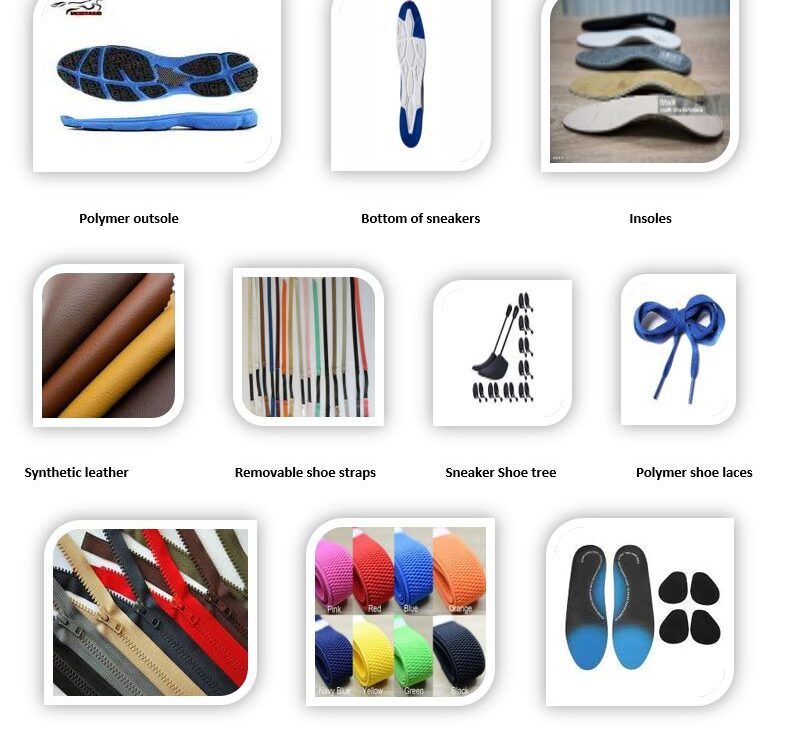Today Polymers have influenced our life style to the extent that, it would not be wrong to say that, we are in polymer age. Now-a-days polymers find wide range of uses starting from common household utensils, automobiles, clothes, footwear, fashion and furniture, to space-aircraft and biomedical and surgical components also.
Polymeric materials are light weight but possess excellent strength & properties which are used in various fields .and are easily processed by different methods to produce all 3 dimensional articles with variety of applications.
Polymers are widely used in the production of non-leather footwear products due to their versatility, durability, and cost-effectiveness.

Applications of Polymers in making Non-leather footwear products:
Synthetic Leather (Synthetics): Polymers such as polyurethane (PU) and polyvinyl chloride (PVC) are commonly used to create synthetic leather, also known as faux leather or pleather. These materials mimic the look and feel of genuine leather but are more affordable and can be engineered for specific properties like water resistance and breathability.
Elastomers: Elastomeric polymers like thermoplastic elastomers (TPE) and thermoplastic polyurethane (TPU) are used to create flexible and stretchable components in non-leather footwear. These materials are often used in the production of shoe soles, providing comfort, shock absorption, and flexibility.
Ethylene Vinyl Acetate (EVA): EVA is a copolymer that combines ethylene and vinyl acetate. It is widely used in the production of midsoles and insoles for athletic and casual footwear. EVA provides excellent cushioning, shock absorption, and flexibility while being lightweight.
Polyester and Nylon: These synthetic polymers are commonly used in the manufacturing of various components in non-leather footwear, such as linings, mesh, and reinforcements. They offer durability, moisture-wicking properties, and are often used in sports and outdoor footwear.
Polyester-based Fabrics: Fabrics made from polyester polymers, such as recycled PET (rPET), are used for the upper part of non-leather shoes. These fabrics can be engineered to be breathable, lightweight, and resistant to abrasion.
Thermoplastic Polyurethane (TPU): TPU is a versatile polymer used in non-leather footwear for creating durable outsoles, toe caps, and other protective components. TPU provides good abrasion resistance, flexibility, and is resistant to oil and chemicals.
Water-Resistant Coatings: Polymers are often employed to add water-resistant properties to non-leather footwear. Various coatings and treatments can be applied to the shoe’s surface to protect it from water, making the footwear suitable for different weather conditions.
Recycled Polymers: With a growing focus on sustainability, recycled polymers are being used in non-leather footwear. Recycled polyester and other eco-friendly polymers contribute to reducing the environmental impact of shoe production.
Thermoplastic Olefin (TPO): TPO is a polymer blend that combines the characteristics of polypropylene and ethylene. It is used in non-leather footwear for its durability, resistance to abrasion, and flexibility.The use of polymers in non-leather footwear provides manufacturers with a wide range of materials to choose from, allowing them to tailor footwear properties to meet specific performance and aesthetic requirements. Additionally, the use of synthetic materials in footwear contributes to animal welfare concerns and supports the development of more sustainable and eco-friendly products.
List of footwear products & components made from polymers & plastics materials
Footwear products and components made from Polymers and Plastics, Rubbers & Elastomeric materials are diverse, offering a range of properties such as durability, flexibility, and water resistance. Here is a list of common footwear products and components made from polymers and plastics:
Outsoles: Made from materials like thermoplastic rubber (TPR), thermoplastic polyurethane (TPU), and polyvinyl chloride (PVC).
Midsoles: Utilizing materials such as ethylene vinyl acetate (EVA), polyurethane (PU), and polyethylene (PE).
Insoles: Often made from EVA foam, polyurethane foam, or other cushioning materials.
Uppers: Synthetic leather made from polyurethane (PU) or polyvinyl chloride (PVC).
Mesh materials made from polyester or nylon. (PET) & (PA)
Lining: Linings within the shoe, often made from polyester or nylon. (PA)
Straps and Fasteners: Buckles, straps, and other fastening components made from various plastics, including acetal and nylon. (POM) & (PA)
Toe Caps and Reinforcements: Thermoplastic components, such as thermoplastic polyurethane (TPU), used for toe caps and other reinforcement areas.
Eyelets and Grommets: Often made from metal or plastic, with plastic variants being common in athletic and casual footwear. (PVC)
Shoe Horns: Shoe horns made from plastic materials for ease of use.
Shoe Trees: Plastic shoe trees used to maintain the shape of the shoe when not in use. (PP)
Velcro Straps: Straps made from nylon or other synthetic materials with hook-and-loop fastening systems. (PA)
Waterproofing and Coating Materials:
Various polymers and plastics used for waterproof coatings and treatments. (PU)
Shoe Soles for Specialty Purposes: For example, anti-slip soles made from rubber or TPU for occupational footwear. (TPU/TPR)
Orthopedic Components: Orthopedic inserts and components made from various plastics for customized comfort and support
Recycled Materials: Increasingly, manufacturers are using recycled plastics, such as recycled PET (rPET), in various components of footwear.
3D-Printed Components: Some high-tech and customized footwear may incorporate 3D-printed polymer components for soles or other structural elements.
Shoe Boxes: The packaging for shoes is often made from plastic materials. (HDPE) & (PP)
Shoe Laces: Traditional shoelaces are made from a variety of materials, including synthetic polymers like polyester. (PET), (ACRYLICS)
Elastics: Used in certain types of footwear, such as slip-on shoes or sneakers, made from elastic polymers. (NR) (SBR) (IR)
This list is endless, as innovations in materials and manufacturing processes continue to expand the range of Plastics & Polymers or Rubber & Elastomers components used in the footwear industry. The choice of materials depends on the desired properties, functionality, and design preferences of the footwear.

The compiler of article is a Senior Faculty in FDP (Material Science) in the School of Footwear Design & Production at Ankleshwar, Gujarat campus is B.E Polymer followed by Diploma in Chemical Engineering from reputed Institutions in Maharashtra state associated with FDDI since Yr. 2014.

(Sr. Faculty, G-II)

